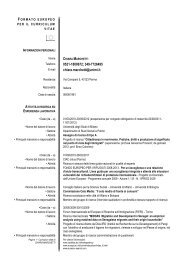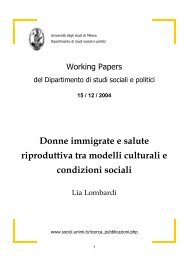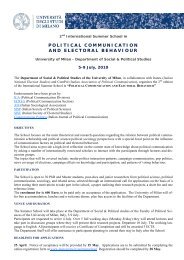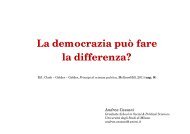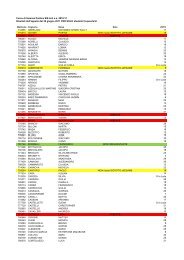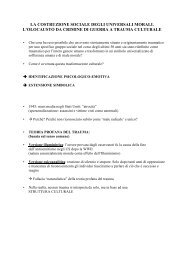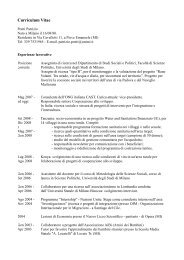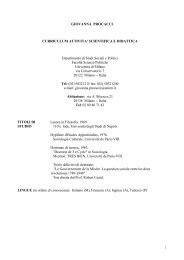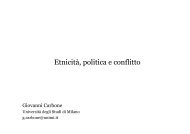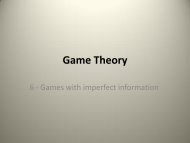The european dimension of political discourse in Italy. A ... - CIRCaP
The european dimension of political discourse in Italy. A ... - CIRCaP
The european dimension of political discourse in Italy. A ... - CIRCaP
You also want an ePaper? Increase the reach of your titles
YUMPU automatically turns print PDFs into web optimized ePapers that Google loves.
THE EUROPEAN DIMENSION OF POLITICAL DISCOURSE IN ITALY.<br />
this perspective, a deeper <strong>in</strong>tegration is considered as a specific priority and a fundamental<br />
goal for the party throughout its <strong>political</strong> <strong>discourse</strong>.<br />
Structur<strong>in</strong>g the longitud<strong>in</strong>al analysis: the <strong>in</strong>teraction between pro-European <strong>discourse</strong>,<br />
phases <strong>of</strong> European Integration and cycles <strong>of</strong> party government <strong>in</strong> <strong>Italy</strong><br />
<strong>The</strong> last clarification concerns the tim<strong>in</strong>g <strong>of</strong> our research: differently from the approaches<br />
focused on the measurement <strong>of</strong> “pro-Europeanism” (or anti-Europeanism) <strong>of</strong> <strong>in</strong>dividual<br />
parties (Ray 1999, Szczerbiak and Taggart 2000) or on the overall impact <strong>of</strong> Europe on the<br />
party systems (Mair 2000), we aim here to f<strong>in</strong>d eventual connections between the re-shap<strong>in</strong>g<br />
<strong>of</strong> “domestic” party <strong>discourse</strong> and the changes at supranational level. <strong>The</strong>refore, a time<strong>in</strong>tensive<br />
strategy <strong>of</strong> <strong>in</strong>vestigation like those proposed by the studies mentioned above would<br />
be <strong>in</strong>adequate.<br />
This leads us to an additional problem, resid<strong>in</strong>g <strong>in</strong> the structural difference between two<br />
historical phases we face here: the period <strong>of</strong> the first republic (1948-1992) is <strong>in</strong> fact<br />
characterised by a very stable <strong>political</strong> elite, while the n<strong>in</strong>eties have been crossed by a<br />
sudden and <strong>in</strong>tense change <strong>of</strong> the party system, which determ<strong>in</strong>ed a significant renewal <strong>of</strong><br />
the <strong>political</strong> elite and, consequently, a potential transformation <strong>of</strong> the <strong>political</strong> <strong>discourse</strong>. We<br />
propose to solve this problem measur<strong>in</strong>g first cont<strong>in</strong>uity and discont<strong>in</strong>uity <strong>in</strong> the <strong>political</strong><br />
<strong>discourse</strong> with<strong>in</strong> the two historical periods, and to leave to the f<strong>in</strong>al part <strong>of</strong> the chapter the<br />
discussion on whether the attitudes <strong>of</strong> party elites have really changed from the first historical<br />
cycle to the other.<br />
However, the pla<strong>in</strong> longitud<strong>in</strong>al comparison between the recent party <strong>discourse</strong> and the “old”<br />
one cannot be an exhaustive way <strong>of</strong> controll<strong>in</strong>g the transformation <strong>of</strong> party elite attitudes <strong>in</strong><br />
<strong>Italy</strong>, because it would not tackle another relevant question <strong>of</strong> the puzzle: the connection<br />
between the significance <strong>of</strong> the European issue and the evolution <strong>of</strong> coalition governance <strong>in</strong><br />
<strong>Italy</strong>. First <strong>of</strong> all, is there a connection? And, <strong>in</strong> case <strong>of</strong> a positive answer, what is the story<br />
<strong>in</strong>fluenc<strong>in</strong>g the other? In order to shed a light on this problem, we can simultaneously show<br />
the series <strong>of</strong> coalition governance cycles (Verzichelli and Cotta 2000) and the ma<strong>in</strong> steps <strong>of</strong><br />
European Integration (figure 4).<br />
FIGURE 4 ABOUT HERE<br />
As one can see, the phases <strong>of</strong> change <strong>in</strong> domestic politics seem rather <strong>in</strong>dependent from the<br />
evolution <strong>of</strong> European <strong>in</strong>tegration. On the other hand, at least two historical turn<strong>in</strong>g po<strong>in</strong>ts<br />
have to be mentioned here, s<strong>in</strong>ce they seem to hold together change at the domestic and at<br />
the supranational level: at the end <strong>of</strong> the seventies, <strong>in</strong> the domestic arena the return to a<br />
“normal” majority-opposition dynamic after a time <strong>of</strong> grand coalition (national) goes together<br />
9



